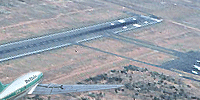 |
 |
|
||||
|
By
Wikipedia,
The Avia BH-9 was a one-seat sport aircraft built in Czechoslovakia in 1923, based on the BH-5. As with other developments in the BH-1 lineage, the BH-9 was a low-wing braced monoplane that accommodated the pilot and passenger in tandem, open cockpits. The BH-9's structure was strengthened to allow for the use of a higher-power engine than in its predecessors, and for the first time, this was a domestically-produced powerplant. The Czechoslovakian Army showed interest in it as a trainer and liaison aircraft, and ordered 10 examples under the designation B.9. A B.9 won the 1925 Coppa d'Italia air race, and the following year, one was flown on a 1,800 km (1,100 mi) circuit Prague-Paris-Prague with an average speed of 131.2 km/h (82 mph). SpecificationsGeneral characteristics
Performance
See alsoRelated development BH-5 - BH-10 - BH-11 - BH-12
Text from Wikipedia is available under the Creative Commons Attribution/Share-Alike License; additional terms may apply.
Published in July 2009. Click here to read more articles related to aviation and space!
|
||||||||||||||||||||||||||||||||||||||||||||||

 |
|
Copyright 2004-2025 © by Airports-Worldwide.com, Vyshenskoho st. 36, Lviv 79010, Ukraine Legal Disclaimer |